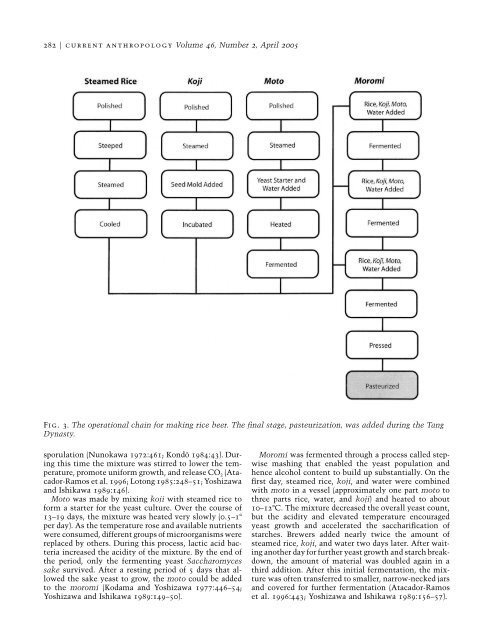2005, Justin Jennings, Kathy L. Antrobus, Sam J. Atencio, Erin ...
2005, Justin Jennings, Kathy L. Antrobus, Sam J. Atencio, Erin ...
2005, Justin Jennings, Kathy L. Antrobus, Sam J. Atencio, Erin ...
You also want an ePaper? Increase the reach of your titles
YUMPU automatically turns print PDFs into web optimized ePapers that Google loves.
282 F current anthropology Volume 46, Number 2, April <strong>2005</strong><br />
Fig. 3. The operational chain for making rice beer. The final stage, pasteurization, was added during the Tang<br />
Dynasty.<br />
sporulation (Nunokawa 1972:461; Kondō 1984:43). During<br />
this time the mixture was stirred to lower the temperature,<br />
promote uniform growth, and release CO 2 (Atacador-Ramos<br />
et al. 1996; Lotong 1985:248–51; Yoshizawa<br />
and Ishikawa 1989:146).<br />
Moto was made by mixing koji with steamed rice to<br />
form a starter for the yeast culture. Over the course of<br />
13–19 days, the mixture was heated very slowly (0.5–1<br />
per day). As the temperature rose and available nutrients<br />
were consumed, different groups of microorganisms were<br />
replaced by others. During this process, lactic acid bacteria<br />
increased the acidity of the mixture. By the end of<br />
the period, only the fermenting yeast Saccharomyces<br />
sake survived. After a resting period of 5 days that allowed<br />
the sake yeast to grow, the moto could be added<br />
to the moromi (Kodama and Yoshizawa 1977:446–54;<br />
Yoshizawa and Ishikawa 1989:149–50).<br />
Moromi was fermented through a process called stepwise<br />
mashing that enabled the yeast population and<br />
hence alcohol content to build up substantially. On the<br />
first day, steamed rice, koji, and water were combined<br />
with moto in a vessel (approximately one part moto to<br />
three parts rice, water, and koji) and heated to about<br />
10–12C. The mixture decreased the overall yeast count,<br />
but the acidity and elevated temperature encouraged<br />
yeast growth and accelerated the saccharification of<br />
starches. Brewers added nearly twice the amount of<br />
steamed rice, koji, and water two days later. After waiting<br />
another day for further yeast growth and starch breakdown,<br />
the amount of material was doubled again in a<br />
third addition. After this initial fermentation, the mixture<br />
was often transferred to smaller, narrow-necked jars<br />
and covered for further fermentation (Atacador-Ramos<br />
et al. 1996:443; Yoshizawa and Ishikawa 1989:156–57).
















